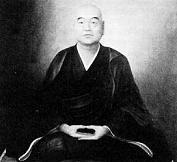


Organic and Inorganic
In his Shobogenzo, Dogen (1200-1253), profoundly realized and brilliant, does not speculate about time and being but speaks about them out of his deep experience. In his section "Being-Time" he states that time occurs because man disposes himself and takes this disposition as the world. As Dogen puts it, "Thus the self setting itself out in array sees itself." Here is another example: "In your study of flowing, if you imagine the objective to be outside yourself and that you flow and move through hundreds and thousands of worlds, for hundreds, thousands, and myriads of eons, you have not devotedly studied the Buddha way."
He views the world not as inert-matter, not as inorganic, but as an organic whole. In a different sense, physics describes organic patterns. This means that particles, bits of matter, are organic energy. Non-scientists think of anything organic as living. This, of course, is not the intent of describing particles that way.
But what can be said about the organic as distinct from the inorganic?
Think about a rock and a human being. My apologies for the rather morbid example, but it serves my explanation. Drop a rock from a cliff, then drop a human being from it. As matter, organic or inorganic, they are both governed by the same law of falling bodies.
The big difference between the rock and the person is that the rock is lifted, held in the hands, then dropped. The person will put up a mighty struggle before going over the edge. One does not act while the other does. To what do we attribute this action?
At least two explanations occur. One is that the human looks ahead, which is to say he has time-consciousness. He can foresee death. He is time-bound while the rock is not.
But perhaps in certain instances some kinds of matter can also look ahead. When photons are fired through two slits, then through one, the particles exhibit a peculiar behavior, which can be interpreted as knowing in advance which slit will be open. (See Wheeler, delayed choice and time and Schrödinger's Cat.) Physicist Henry Stapp puts it this way: "The central mystery of quantum theory is ' How does information get around so quickly? ' " ("Are Superluminal Connections Necessary?," Nuovo Cimento, 40B, 1977)
Another explanation. Human reaction occurs much more quickly than does inert matter's. Iron reacts to oxygen by forming rust. Sodium reacts to chlorine by forming sodium chloride. Both people and inert matter are time-bound and both respond in different lengths of time. The rock will fall without struggle, markedly different than the person, but one cannot say of the human that he alone is time-bound--only that he can look ahead, which is not a property of the rock.
An additional explanation is that human beings have choice. The struggle occurred because the individual chose to struggle. Perhaps. Certainly humans respond through an intricate complex of factors. Today much empirical evidence indicates that the individual is programmed by genes, and by environment (maybe even by the Big Bang some fifteen billion years ago). The individual puts up a fight because the struggle to survive, as one example, is innate and can be found in all life forms, from plants, with tropisms to turn from pain, to animals, with immediate responses.
For this brief commentary I have lumped together applications of the term organic but, even were they treated separately, a central question would remain. Can we clearly delineate between the organic and the inorganic? Is it more instructive to think of everything as organic? Neils Bohr concluded that both organic and inorganic matter are constructs which cannot be used simultaneously in the same situation. Nonetheless both are required for a complete complementarity description of a quantum event.
To maintain a distinction between inorganic and organic, we must reduce things to less than they are. By themselves neither sodium nor chloride is novel, yet together they produce salt, an emergent property, which cannot be fully explained by its parts. The DNA in our bodies has never died, but instead emerged into new properties out of bacteria swimming in primordial seas. (See One Life.) In each case, where does the inorganic end and the organic begin?
Douglas Harding has pointed out that to think of this planet as a life-infested rock is as absurd as thinking of the human body as a cell-infested skeleton. How can the organic and inorganic be separated? (See his link under Consciousness in the sidebar.)
We are imprisoned by a way of seeing, to include distinguishing between organic and inorganic. In the exercise of intellect, we must distinguish, and should, as reason is a noble faculty, but we should also understand that we and every organism create our own environment. Our knowledge of the world is, in one sense, self-knowledge. We "know" the world into a translation of events as bodily processes via the nervous system and brain. Bees can tell the position of the sun by observing a patch of blue sky. Bats echolocate their flight path with a kind of sonar.
Dogen does not answer any question directly, but instead poses new ways of being aware. Of dichotomies such as that between organic and inorganic, he points out our tendency to category awareness: "The flowers depart when we hate to lose them; The weeds arrive while we hate to watch them grow." He promotes a different way of seeing with such questions as these: "Is there a real basis inside or outside your body now? Your body with hair and skin is just inherited from your father and mother. From beginning to end a drop of blood or lymph is empty. So none of these are the self. What about mind, thought, awareness, and knowledge? Or the breath going in and out, which ties a lifetime together: what is it after all? None of these are the self either." (Gakudo Yojinshu*, written in 1234. * Guidelines For Studying The Way.)
